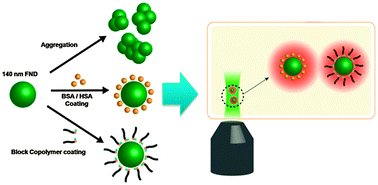Fluorescent nanodiamonds (FNDs) are very promising fluorophores for use in biosystems due to their high biocompatibility and photostability. To overcome their tendency to aggregate in physiological solutions, which severely limits the biological applications of FNDs, we developed a new non-covalent coating method using a block copolymer, PEG-b-P(DMAEMA-co-BMA), or proteins such as BSA and HSA. By simple mixing of the block copolymer with FNDs, the cationic DMAEMA and hydrophobic BMA moieties can strongly interact with the anionic and hydrophobic moieties on the FND surface, while the PEG block can form a shell to prevent the direct contact between FNDs. The polymer-coated FNDs, along with BSA- and HSA-coated FNDs, showed non-aggregation characteristics and maintained their size at the physiological salt concentration. The well-dispersed, polymer- or protein-coated FNDs in physiological solutions showed enhanced intracellular uptake, which was confirmed by CLSM. In addition, the biocompatibility of the coated FNDs was expressly supported by a cytotoxicity assay. Our simple non-covalent coating with the block copolymer, which can be easily modified by various chemical methods, projects a very promising outlook for future biomedical applications, especially in comparison with covalent coating or protein-based coating.

You have access to this article
 Please wait while we load your content...
Something went wrong. Try again?
Please wait while we load your content...
Something went wrong. Try again?


 Please wait while we load your content...
Please wait while we load your content...